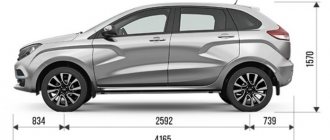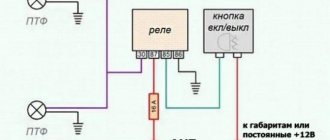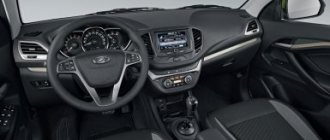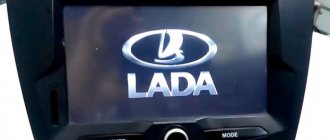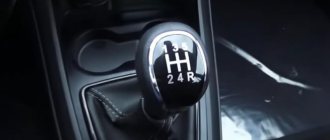About the design
What does an AMT gearbox consist of? This transmission includes several components:
- Drive and clutch discs.
- Gear shift lever.
- Electronic control system.
Any robot uses a double friction clutch. On conventional mechanics, one disk is used. This design allows for faster gear shifting on AMT. The Lada Vesta, on which robotic gearboxes began to be installed, is much faster than its manual counterpart. And this despite the fact that the AMT does not have a clutch pedal as such. But not only the Volkswagen-Audi concern and AvtoVAZ use such a box.
The latest generation of Lada Vesta with mechanics and real reviews from car owners
It is quite reasonable that the new Lada Vesta AMT and reviews from owners have their fans, but the current manual transmission is also not losing ground. Most car owners note that compared to the old box, the noise level is significantly lower. In addition, the advantages of JH3 include:
- More precise adjustment of switching mechanisms.
- The defect of difficult gear changes caused by oil thickening at low atmospheric temperatures has been eliminated.
- Clear shifts and reliable locking of the gearbox lever.
Almost all positive reviews of Lada Vesta mechanics are characterized by the opinion of Pavel T. from Tambov:
“If anyone drove the previous models, they will immediately feel the difference. The JH3 manual lever from Renault pleases with its moves and selectivity. Unlike the Lada 2181 gearbox, which uses a cable shift mechanism, the imported manual transmission is significantly quieter.”
Conflicting opinions are caused by the fact that the French box is maintenance-free. If in the previous design of the manual transmission the hum could be weakened by replacing the transmission lubricant, now the plant fills in lubricating fluid for the entire operating life.
Despite the warranty obligations of AvtoVAZ, experts still recommend changing the oil every 100,000 km. It is rational to combine this procedure with changing the clutch. In addition, be sure to monitor the transmission fluid level, which should not be lower than the lower edge of the filler hole. It seems that everything was done with the car enthusiast in mind, but, for example, reviews from the owner of a Lada Vesta with a manual transmission, Andrei P., contain some complaints:
“You will hardly be able to immediately engage reverse gear on a manual transmission. The car service is not able to offer anything, citing imperfections in the design... Over time, I adapted (what to do) - I first turn on third gear, and then reverse. This “imperfection” is especially noticeable in winter, when the lubricant thickens.”
Clutch types
There are several types of clutches for AMT gearboxes:
In the first case, electric motors are used. This type of drive has a slower response speed. Gear shifting is three to four times slower than a similar one with a hydraulic drive. Switching time ranges from 0.3 to 0.5 seconds. But still faster than an automatic transmission.
What owners' reviews say about the Lada Vesta with an AMT gearbox: features of the robotic transmission
If your goal is a cheap car with automatic transmission, then we must admit that the Lada Vesta would be a good choice in this case. For example, as a comparison with KIA Rio , not only is the Russian budget sedan in the basic version cheaper than its competitor, but also the surcharge for a two-pedal model is half as much – only 25,000 rubles.
Briefly about the VAZ automatic transmission
The adequate cost of the car is explained by the fact that the robotic gearbox was developed in AvtoVAZ’s own workshops. The basic product was a cable manual transmission number 2180, but electric actuators from ZF were used as the actuator. The new unit received the index 2182 and was tested on Priora.
Unfortunately, the VAZ robot is equipped with a single-plate clutch, which affects the speed of gear shifting. For example, gearboxes with a double-disc clutch change gears almost instantly, because when one clutch opens, the second is already ready to engage the desired gear.
On the Lada Vesta, the operation of the automatic system resembles the actions of the driver when operating a manual gearbox - the discs open, the gear changes, and the clutch closes again. It is precisely the “thoughtfulness” at the moment of switching that explains the negative reviews from the owners of the new Lada Vesta with the co-produced AMT gearbox. But you don’t need to think about setting up the clutch like in Priora - it seems to be there, but there is no control pedal.
Advantages and disadvantages of robotic transmission
Among the shortcomings, the most common complaints are about difficulties when starting downhill or when descending. The car manages to roll back a little, and when you press the brake, the clutch discs open again. You have to use the handbrake, but what can you do – it’s not an automatic. Another point that irritates some drivers:
“Unfortunately, the robotic box cannot determine when the driver decides to press the gas. At maximum thrust, a gap of 1.7 seconds between transitions is quite a long time. Fortunately, there is a manual mode for this, which allows you to maintain adequate traction and the absence of temporary pauses.”
- Availability of two operating modes and prevention of incorrect gear selection.
- Possibility of resetting one or two gears at once.
- Ensuring economical fuel consumption.
- No need for warming up at low ambient temperatures.
- The car can be started from a pusher, having previously accelerated it to 5-7 km/h, and then turned on mode “A”.
- There are no contraindications when towing; as a tractor, the recommended speed is no more than 25 km/h.
- No routine maintenance is provided; oil is filled for the entire service life.
- The presence of a wear compensator in the clutch actuator.
Advantages
The main advantages of an automated transmission:
- Low fuel consumption. A robotic car spends almost the same amount as a manual one.
- Small amount of oil. Up to 4 liters of liquid must be poured into such a box. This is two times less than with a similar automatic transmission or CVT.
- High clutch life. Since the switching process is controlled by electronics, and not by the driver, the risk of burning the clutch is close to zero (unless you intentionally press the gas and brake pedals at the same time).
- Availability of semi-automatic mode. At any time, the driver can switch to manual mode and independently choose the moment when to shift to a higher or lower gear.
Drivers also note high switching speeds even in automatic mode. And all thanks to the use of a multi-disc clutch. When the car is moving in first gear, the second disc is already engaged with the next one.
All about AMT. Behavior after break-in.
Good afternoon, dear Dromovites!
What made me write this general post is the fact that most people discussing the disadvantages/advantages of the AMT Vesta do not have a detailed understanding of this transmission.
First, some general information:
1. The AMT is based on a modified VAZ 2180 manual transmission. 5 speeds. In the Vesta AMT the gear ratio of the main pair is 3.9; on Kalinas and Grants it is 3.7. On AMT Kalina 120 km/h corresponds to 3000 rpm. per minute, Vesta: 3,150-3,200.
2. You can’t just take and “screw” a “canopy” of actuators and an electronics unit to a regular VAZ 2180 manual transmission to get an AMT output. In terms of hardware, the AMT differs from the manual transmission by a modified housing, a different input shaft with a rotation sensor + a few more “little things” (this is in brief).
3. The ZF actuator unit is maintenance-free. Estimated service life is 10 years. The current cost is about 20 thousand rubles. Not a single failure of this unit has been recorded yet.
4. “Clutch assembly” AMT modified (relative to manual transmission). The cost of replacement at the moment is about 5.5 thousand rubles. from the officials. Its service life depends on the driver for the most part. AMT tries to take care of him (behaves like a “retired” driver). No failures were noticed during early runs (up to 30 thousand km). There are no routine adjustment work until its “death.” In theory, it should last at least as long as an ordinary driver (not a racer!)). On average it is about 100 t.km. during urban use.
5. Oil poured into the AMT is not officially subject to replacement until 120 thousand km. Unofficially, engineers advise changing to 75 t.km.
6. AMT on cars with ESP (Vesta and, more recently, Kalina) is additionally tied to the ESP and HSA system (slope holding system. That is, in turns, AMT “holds gear” without allowing a break in the power flow between the wheels and the engine .
7. AMT - adaptive transmission. Every second (or rather, each cycle of execution of the main program of the AMT controller. This is several tens of ms), its controller reads data from the engine control units, ESP (ABS), gearbox sensors, gas and brake pedals in order to form the necessary actions according to the interference of the basic gear shift maps and variables from long-term memory (where the driver’s actions in certain situations are recorded and dynamically adjusted).
In non-technical terms: the box adapts to the driver's driving style and road conditions. To do this, she needs time (according to my observations, this is several tens of kilometers in the city).
8. Kick-down mode is always available. However, in the “M” mode, if the first gear is engaged, the AMT will not switch to a higher gear until the driver swings the lever to the “+” position (from the second and higher it will shift at the cutoff).
9. AMT quickly detects an increased load (slope or towing someone) and uses the maximum possible engine torque. Those. drives “on the spot”: switches this way. so that the next gear is engaged at least 2.5 t.r.o. per minute and switches to the next gear when it reaches at least 4 - 4.5 rpm. in a minute. The applied torque depends on the amount of load on the engine: for example, on a slight slope, the AMT will simply switch to a lower gear, but will not crank it up, remaining in the economical gear shift corridor.
10. In “M” mode, AMT changes gears faster (about 150-250 ms) than in “A” mode. When the speed decreases (when the engine speed in the selected gear drops to idle), the AMT will automatically engage a lower gear. Accordingly, when reaching maximum speed - increased (with the exception of the first: see point 8).
Differences between AMT versions:
1. On Priors, Grants and Kalinas without ESP there is no slope retention system.
2. On Westas, shifts are softer and smoother (in “A” mode) than on Viburnums and others like them. But the shifts are slower. They have different calibrations and software settings.
Operational features of AMT:
1. There is no separate “P” (“parking”) mode. But the AMT can be left in gear. To do this, you need to turn off the engine in modes “A” or “R”. With the engine off, you can move the AMT lever to the “N” position, the gear will remain engaged. The next time you turn on the ignition, the clutch will open automatically (i.e., you will need to press the brake pedal to prevent the car from rolling away).
2. The car starts only when the brake pedal is pressed and the AMT lever is in “N” position. Autostart can be implemented in the same way as on cars with manual transmission.
3. All versions of AMT do not have a “creeping” mode. The car will start moving only when you press the gas pedal.
4. During long stops (for example: before a railway crossing), it is advisable to move the AMT lever to the “N” position. Those. act in the same way as a driver with a regular manual transmission. When mode “A” or “R” is turned on and the gas pedal is not pressed, the clutch is open and there is a load on its release bearing.
5. Engine braking is possible, but slowly (in higher gears). AMT quickly includes lower gears.
However, I was convinced from my own personal experience. that it is better to assist engine braking with the brake pedal.
6. During smooth braking (with the brake pedal), the AMT additionally brakes with gears, but during intense braking, the AMT opens the clutch (there is a feeling that there is a small “sink” in the brake pedal).
7. After heavy braking, the clutch will remain open until the gas pedal is pressed. Those. after pressing the gas pedal there will be a pause before acceleration (necessary for smooth closure of the clutch disc). It lasts about 0.5 seconds. When braking smoothly, the pause is shorter or absent.
8. When you hit the brake pedal sharply, the BAS (Brake Assist) system is activated even before the ABS is activated. The clutch will immediately open.
Next, I summarize the impressions and characteristics of AMT behavior in various conditions.
-==1. Run-in.==-
Immediately after leaving the car dealership, any normal driver will get used to driving a car. This is also true for short test drives of a car that has not yet been broken in. And most likely AMT mode “A” will be used. Therefore, he is unlikely to start “giving heat” with the gas pedal. AMT will switch as smoothly as possible (i.e., also slowly, but there will be a separate paragraph about switching speed below) and when it reaches 2-2.5 rpm. As you might guess, this will cause the first reaction - “Robot is Stupid!!!”. In the editors of Droma, this term is called “robot freezes.”
In order to “stir up” the robot, you need to press the gas pedal more actively. The 21127(9) engine, although with variable intake manifold geometry, is never TSI with its maximum torque available from 1500 rpm. per minute Therefore, during the break-in period, it is worth turning the engine in the city. Preferably up to 3000 rpm. per minute in first gear. Then the AMT will work noticeably faster.
From first impressions: you can drive like a regular automatic: holding down the gas pedal until the required speed is reached. During smooth acceleration, the dives are unnoticeable; shifts feel like a gust of headwind on the highway. The switching speed directly depends on the main operating mode of the AMT combination and the engine, i.e. During the break-in period, these switchings are not as fast as after its completion. The switching time ranges from 0.8 to 1.5 seconds.
On an AMT without an HSA system, the car rolls back on a slope. Those. when you quickly move your foot from the brake pedal to the gas pedal, the car can roll down several tens of cm (depending on the magnitude of the slope). This needs to be taken into account. I usually just move my foot, but on some slopes I work “with two feet”: I press the brake with my left and smoothly press the gas with my right. With this method, there will be no rollback: as soon as the AMT feels the presence of a slope (with the brake pedal already released), the engine speed and the degree of slip of the clutch disc are immediately adjusted. It is impossible to stall on AMT.
I'll quote myself:
“In a smooth flow, the robot works slower (in the sense of changing gears). That's noticeable. Let’s say if you drive like a classic automatic, holding a certain speed, then the shifts are noticeable from first to second and from second to third. Shifts to fourth and especially fifth are almost imperceptible. How does the switching feel: when switching to second (by default it occurs somewhere at 2.5 tons of rpm), the robot disengages the clutch, forcibly reduces the speed and engages the clutch. It's like a gust of headwind on the highway. Switching takes about 1 second. From second to third everything is the same, only it switches a little faster (it feels like about 0.7-0.8 seconds) and smoother. You can still feel the shift to fourth, but it switches to fifth imperceptibly.
AMT operation, some features:
1. You can tell the robot to change gears using the gas pedal. To do this, when you reach the required speed for switching, slightly reduce the pressure on the gas pedal (as if you lower the engine speed on a conventional manual) for about half a second. While the revolutions were dropping (i.e. in the same 0.5 seconds), the robot had already stuck into the next gear. Tested several times, very comfortable switching.
….
5. On the track, the robot maintains gear and speed. Those. There is some kind of cruise control: even if you completely remove your foot from the gas pedal, the revs remain for some time and the speed does not decrease. I had to get used to this. Without pressing the brake pedal, the car does not slow down (at least this applies to flat sections of the road without a slope).”
-==2.Traffics==-
In traffic jams, you need to divide them into their type:
1. Standing traffic jam. Those. drove 5 meters and stopped. In this mode, I didn’t bother working with the gas pedal at all: I pressed the gas smoothly, the car always moved off equally smoothly, I released the gas pedal and the car rolls until it stops either by itself or with the help of the brake pedal. And so on until next time. If the plug is dead, then when stopping, move the AMT selector to the “N” position. If not, then in this mode there are no differences from the machine (except for the absence of a “creeping” mode).
2. Smoothly creeping cork. Those. Then you stand for a minute, then you drive for half a minute (or vice versa). The speed is walking speed. In this mode, the following feature of AMT was revealed (I will quote myself again):
“When driving in a very sluggish traffic jam, AMT requires a very gentle press on the gas pedal.
Let me explain: if I were driving a manual, 1st gear would be constantly engaged and there would periodically be “too much” at idle. Those. I would periodically squeeze the clutch and brake. AMT in this case does the same: i.e. When the gas pedal is released in first gear, it releases the clutch. The point is that when coming to a complete stop, the AMT always starts off equally softly, but if the car is still rolling and you need to accelerate slightly, then when you add gas, the AMT takes a pause and the driver instinctively adds a little more gas (as if instead of 1200-1300 rpm .per minute you give 1400-1500). Then the AMT comes to its senses and allows the clutch to close. It turns out to be a small push in the back.
It was established experimentally (what else to do in a traffic jam? :-)) that the treatment is quite simple: you need to not increase the speed so sharply. It's corny, but it works. Those. AMT clearly monitors not only the position of the gas pedal, but also the rate of change of this position.”
-==3.Gear shift speed==-
This is one of the most difficult points. And probably one of the most discussed in AMT's work. So how long does it actually take to change gears? It feels very fast after running in. In crawling mode through traffic jams, running in is significantly slower.
Let us turn to the research of the Autoreview magazine from their following article:
https://www.autoreview.ru/_archive/section/detail.php?ELEMENT_ID=151068&SECTION_ID=8190
Without thinking twice, I took the following graph from this article:
In this graph, I highlighted the period of time when the clutch is completely open and the actuators directly change gear. For AMT Kalina this time is about 0.33 seconds, for Vesta this time is longer: about 0.5 seconds.
If you look at the curves for the drop and rise in torque, you can see how quickly the clutch opens on the AMT of the Viburnum and how much slower it makes the AMT of the Vesta. However, this is even more relevant for the clutch engagement curve: the AMT viburnum spends another 0.2 seconds to engage (smoothly, I note! Even with the gas pedal fully depressed!) the clutch until the point of crossover between the torque lines of the clutch and the engine, from this point the engine torque is already transmitted on the wheels, but the clutch will still slip. It will turn on completely in 0.35 seconds.
To summarize: the time when torque from the engine is not transmitted to the wheels is about 0.53 seconds for AMT Kalin\Grant\Prior.
For AMT Vesta, the following figures are relevant: 0.5 for switching + 0.5 before the transmission of torque to the wheels begins + 0.1 s for full activation.
The guys from Auto Review measured the total time for shifting gears from the beginning of the clutch disc opening until it is completely closed. In this case it is 1.45 s. for viburnum and 1.72 for Vesta.
However, it seems to me that what is important is not the total shift time, but the time from the clutch disc opening until the next gear begins to supply engine torque to the wheels. After all, it is precisely this moment that we all feel (as if “grabbed by the butt.” This is especially true for the most intense acceleration). During smooth acceleration, these transitional moments are not felt at all. Even when switching from the first to the second (see my previous addition with the first video).
In “M” mode, you can subtract the disc opening time from the total gear shift time; it occurs almost instantly. And the disk closes much more fun. The switching time itself is also reduced by about 100 ms (which AMT spends on determining the required gear). But all the same: the shifting is comfortable, without shock engagement of the gear and shock engagement of the clutch. So AMT is still not made for “racing” (but you can fool around :-)).
-==4.After running in=—
I'll start by describing the sensations. The points:
1. AMT switches have become timely and fast. The robot adapted to me, and I adapted to it.
2. I stopped using the “M” mode. I don’t see much point in it under normal operating conditions (without “off-road”), I force the robot to switch when I want. Only sometimes on slopes does he helpfully change gears and over-throttle so that I can continue driving “on the fly.”
What should you do to prevent the “robot from being stupid”:
1. During a smooth start, if you suddenly unexpectedly (for AMT) decide to “spur the horse” at the moment of switching from first to second, do not press the gas all the way. Still, this will not help you change gear faster. But when the second one turns on, the acceleration will be linear and quite noticeable (unless, of course, you release the gas pedal). Therefore, if you decide to start abruptly, just bluntly press the gas. AMT will accelerate as efficiently as possible (within the limits of grip and engine power, of course) with minimal switching time from first to second, etc.
2. In traffic, try to accelerate within the current gear: this will allow you to make maximum use of the engine torque over a wide range. Tell the robot when to switch with the gas pedal. Then the robot quickly adapts to your driving style.
3. Do not forget that you can only switch from neutral to “A” (or “R”) with the brake pedal depressed. Although you can switch from “A” or “R” to “N” on the fly without pressing the pedal.
Thank you. that you read this sheet to the end! :-) I hope that you found it interesting.
Operating modes of the automated box
While driving, the driver can set the gear shift lever to automatic or semi-automatic mode. In the first case, the transmission operates by relying on sensor readings and impulses from the electronic control unit. As for the semi-automatic mode, “Tiptronic” is activated here, which can be found on Mercedes cars with their automatic transmission. There is a plus/minus switch on the gear lever.
What's on the road: reviews from some owners of the 2016 Lada Vesta robot?
Experienced motorists liked the ability to move the gearshift handle from the forward position to Reverse when slipping at a speed of less than 3 km/h. At the same time, switching time is reduced to 0.7-0.8 seconds. However, drivers do not recommend abusing this - the clutch overheating indicator may go off, and you will have to wait until the clutch cools down.
Manufacturers of the Lada Vesta robot and reviews from owners in 2016 claim that shifts have become smoother than those of Kalina or Priora, but longer. The box was reconfigured and the original control unit was installed on it. Loss of traction for 1.7 seconds in city traffic threatens, at a minimum, with the horns of hurrying drivers. Meanwhile, it is possible to select manual mode and work ahead.
Some dissatisfaction is caused by difficulties with parking, which Anatoly P. from Tula talks about:
“I don’t know, maybe this is how it should be - after turning off the ignition, moving the selector to position “A” will not work, the box will remain in neutral. You can’t do without a handbrake, but what if the pads get stuck in the winter. I suggested on the forum to turn off the engine in mode “A”, but some immediately assumed a situation where the battery was discharged. It’s good when there is somewhere to light the battery , but what if not? And here we have to agree - the robotic gearbox lacks the Shift Lock function, which allows you to manually engage neutral gear.”
You should not associate the proud name of the transmission mechanism with concepts about the driver's driving style. Judging by the reviews of owners of Lada Vesta with an AMT gearbox, this option is suitable for people who are in no particular hurry. It is this category of drivers who appreciate the robotic transmission:
“You need to get used to such a box; some people think that a robot is practically the same as an automatic machine, and they don’t use the gas pedal when starting. In this case, the clutch closes for a long time and has time to heat up. But, when adding traction, the car starts much faster, without jerking or vibration. So you need to work with the accelerator carefully, as if it were a simple manual transmission.”
As experienced motorists say, downward shifts occur in two scenarios. When the traction is released, the transition is practically unnoticeable - the car brakes in V gear with the engine, only at 1,200 rpm does the transition to a lower speed begin. This “tactic” allows you, if necessary, to immediately begin to gain speed without a pause.
Types of manual transmission
In its development, the “robot” went from “almost mechanical” to “automatic”; reliability and speed of operation increased accordingly. The first manual transmissions practically duplicated the design of a manual transmission, adjusted for a different mechanism drive principle. They were replaced by robotic gearboxes with two clutches, and now they have made a real revolution in views on this type of transmission.
Manual transmission with one clutch
Robotic gearbox with one clutch
First experience, first swallows, first mistakes. A robot with one clutch duplicates a manual gearbox in its principle. In the same way, with the help of a clutch, the drive shaft is connected to the engine crankshaft, and from it the torque is transmitted to the driven shaft through synchronizer gears.
Test drive Lada Granta Cross on a “robot”: tests on the M5 highway and village dirt
Sometimes it is difficult to take on the role of a lawyer because you know in advance that the case will be lost. But it’s either passion, or duty and a matter of honor - and you take it on. It's boring at first: all the scripts are known in advance and differ only in details, like good remakes. But as you dive in, something clicks inside, and the “bartender” you’ve known since birth slips you a strange cocktail of sympathy, empathy and hope... And with this Lada Granta Cross it couldn’t be otherwise.
What does it look like
Everyone has already been able to get an idea of the appearance of Granta Cross. This is the same Kalina Cross, which, after restyling in the summer of 2018, had to unite with the Grants family, forming a powerful clan with the best sales results that have been maintained for many months. If you want a quick summary, the Lada Granta Cross looks great.
Disadvantages, breakdowns and problems of AMT
The robot inherited from the mechanics of the 2180 regular oil leaks from the seals. There is nothing much you can do; carefully monitor the lubricant level.
Sometimes the robotic box goes into a stupor and stops responding to commands. In this case, only flashing the control unit will help you.
Sometimes vibrations bother you when the clutch disc wears out at low mileage. Only replacement helps. In 2016, AvtoVAZ changed its supplier and the problem went away.
The following video will tell you in detail about the symptoms of sudden transmission overheating.
Lada Vesta and manual transmission: five reasons to buy for and four against
A certain part of motorists continue to ignore the achievements of transmission cybernetics and choose cars with a manual transmission. If we analyze their arguments, we can formulate five main reasons based on which it is worth considering this option:
- Affordable price - the basic model costs 509,000 rubles, for the robot you need to add 25,000 rubles. If you take a car with a manual transmission, then for the money you can get a higher level of equipment. A new AMT robot unit from a dealer costs 56,200 rubles, plus about 10,000 more for installation, so if something happens, the amount for repairs is quite impressive, which cannot be said about a manual gearbox.
- Full configurations – for models with manual transmission there is no discrimination in terms of configurations. If you want a “full stuffing” of a car, that’s not a question, and it’s not necessary to take a robot because of the additional options.
- Pleasant dynamics - according to documents, a car with a manual transmission accelerates to 100 km/h 1 second earlier than its automatic counterpart. In practice, this is significant time, which does not allow you to sweat when overtaking.
- Reliability - according to reviews and tests of the Lada Vesta, the mechanics did not give any particular cause for alarm, especially since in case of repairs the costs will be significantly lower.
- Potential liquidity - after a certain time, selling a car with a manual transmission on the secondary market will be much easier.
Factory AMT gearbox on Priora: price and article number
The new gearbox in VAZ was developed on the basis of an old frozen project. In 2009, the development of a manual transmission for golf-class cars was closed, but good performance led engineers to the idea that the VAZ-2116 gearbox, a new generation of manual transmission, could become a prototype for an automatic transmission.
A robotic automatic transmission with electric actuators from ZF is now used in front-wheel drive Ladas. The automatic transmission has code 2181 for Kalina and Granta, and the Priora has an automatic transmission with code 2182. A Lada Priora car with AMT at the dealer and on the secondary market costs about 20 thousand rubles more than a Priora with a “mechanics”. It works in four positions: R, N, A and manual gear shift (“+” is responsible for upshifting, “-” is responsible for downshifting).





